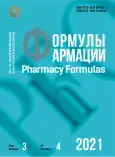Development of the emulsion composition and technology based on iron oleate micelles
- Authors: Trofimov M.A.1, Goncharenko A.A.2, Plisko G.A.3, Semivelichenko E.D.3, Muslimov A.R.2, Ivkina A.S.3
-
Affiliations:
- Alferov Saint Petersburg National Research Academic University of the Russian Academy of Sciences
- “QR.bio”, LLC
- Saint Petersburg State Chemical and Pharmaceutical University
- Issue: Vol 3, No 4 (2021)
- Pages: 28-34
- Section: Biomedical Sciences
- URL: https://journal-vniispk.ru/PharmForm/article/view/106232
- DOI: https://doi.org/10.17816/phf106232
- ID: 106232
Cite item
Full Text
Abstract
This paper addresses the problem of drugs for the treatment of iron deficiency anemia (IDA). Iron deficiency anemia is a clinical and hematological syndrome based on a violation of hemoglobin synthesis resulting from iron deficiency. Clinically, IDA is manifested by symptoms of anemia and sideropenia. The aim of the study is to develop new drugs for the treatment of IDA based on lipophilic iron compounds with oleic acid in the form of a microemulsion. Analogues of the developed compounds are presented on the pharmaceutical market, being registered exclusively as biologically active food additives (Lipofer, Sideral Forte). During the study, the following materials and methods were used: iron (III) oleate with an iron ion concentration of 25 mg/g was obtained by mixing 1.1 g (0.03 mol) of iron nitrate with 6.0 g (0.21 mol) of oleic acids. After that, the mixture was heated to 90℃ for 24 hours under constant stirring. To 3 g of the previously obtained iron (III) oleate solution, 0.56 g of ascorbyl palmitate was added in an equimolar ratio to the iron ion. The mixture was stirred for 24 hours at 90℃. The resulting iron (II) oleate emulsion showed the presence of divalent ions at a concentration of 4.77 mg/g. The total concentration of iron ions in the analyzed oleates of both types was the same. Recalculation for the initial solution in oleic acid showed that the concentration was close to the expected values. Solutions for quantifying the concentrations of the active substances of the drugs under development have been presented. The fundamental possibility of carrying out the in situ reduction of the iron ion in oleic acid using a lipophilic reducing agent, ascorbyl palmitate, has been demonstrated.
Full Text
##article.viewOnOriginalSite##About the authors
Mikhail A. Trofimov
Alferov Saint Petersburg National Research Academic University of the Russian Academy of Sciences
Email: mihail.trofimov@pharminnotech.com
Postgraduate at the Department of Condensed Matter Physics
Russian Federation, Saint PetersburgAlexander A. Goncharenko
“QR.bio”, LLC
Email: alexs.goncharenko@yandex.ru
Chief Operating Officer
Russian Federation, Saint PetersburgGrigory A. Plisko
Saint Petersburg State Chemical and Pharmaceutical University
Email: grigoriy.plisko@pharminnotech.com
Researcher at the Center for Experimental Pharmacology
Russian Federation, Saint PetersburgEvgeny D. Semivelichenko
Saint Petersburg State Chemical and Pharmaceutical University
Author for correspondence.
Email: evgeniy.semivelichenko@pharminnotech.com
Researcher at the Center for Experimental Pharmacology
Russian Federation, Saint PetersburgAlbert R. Muslimov
“QR.bio”, LLC
Email: albert.r.muslimov@gmail.com
General manager
Russian Federation, Saint PetersburgArina S. Ivkina
Saint Petersburg State Chemical and Pharmaceutical University
Email: arina.ivkina@pharminnotech.com
Senior Researcher at the Center for Experimental Pharmacology
Russian Federation, Saint PetersburgReferences
- Cappellini M. D., Musallam K. M., Taher A. T. Iron deficiency anaemia revisite. J. Intern. Med. 2020;287(2):153–170.
- Soppi E. T. Iron deficiency without anemia - a clinical challenge. Clin. Case Rep. 2018;6(6):1082–1086.
- Goddard A. F., et al. Guidelines for the management of iron deficiency anaemia. Gut. 2011;60(10):1309–1316.
- Litin S. C., Nanda S., eds. Mayo Clinic family health book. Fifth edition. Rochester, MN: Mayo Clinic; 2018. 1391 p.
- Balashova E. L., Mazur L. I. Current approaches to diagnosing iron-deficiency anemia in children. Rossiyskiy vestnik perinatologii i pediatrii = Russian Bulletin of Perinatology and Pediatrics. 2015;60(4):31–36. (In Russ.).
- Romashevskaya I. P., Koshkevich V. V., eds. Sovremennye podkhody k diagnostike i terapii zhelezodefitsitnykh anemiy. Gomel’: RNPTsRMiECh;; 2018. 16 p. (In Russ.).
- Tolkien Z., et al. Ferrous Sulfate Supplementation Causes Significant Gastrointestinal Side-Effects in Adults: A Systematic Review and Meta-Analysis. PLOS ONE. 2015;10(2):e0117383. https://doi.org/10.1371/journal.pone.0117383
- Biggar P., Hahn K.-M. Importance of the different i.v. iron generations for everyday medical practice. MMW Fortschr. Med. 2013;155(Suppl 1):18–24.
- Geisser P. Safety and Efficacy of Iron (III)-hydroxide Polymaltose Complex. Arzneimittelforschung. 2011;57(6):439–452.
- Santiago P. Ferrous versus Ferric Oral Iron Formulations for the Treatment of Iron Deficiency: A Clinical Overview. Sci. World J. 2012;2012:1–5.
- Sharma A., Madhunapantula S. V., Robertson G. P. Toxicological considerations when creating nanoparticle-based drugs and drug delivery systems. Expert Opin. Drug Metab. Toxicol. 2012;8(1):47–69.
- Paliwal R., et al. Solid lipid nanoparticles: a review on recent perspectives and patents. Expert Opin. Ther. Pat. 2020;30(3):179–194.
- Miller C. J., Rose A. L., Waite T. D. Importance of Iron Complexation for Fenton-Mediated Hydroxyl Radical Production at Circumneutral pH. Front. Mar. Sci. 2016;3. https://doi.org/10.3389/fmars.2016.00134
- Kell D. B. Towards a unifying, systems biology understanding of large-scale cellular death and destruction caused by poorly liganded iron: Parkinson’s, Huntington’s, Alzheimer’s, prions, bactericides, chemical toxicology and others as examples. Arch. Toxicol. 2010;84(11):825–889.
- Droke E. A., Briske-Anderson M., Lukaski H. C. Fatty Acids Alter Monolayer Integrity, Paracellular Transport, and Iron Uptake and Transport in Caco-2 Cells. Biol. Trace Elem. Res. 2003;95(3):219–232.
- Nagy K., Tiuca I.-D. Importance of Fatty Acids in Physiopathology of Human Body. In: Catala A., ed. Fatty Acids. London: IntechOpen; 2017. 248 p.
- Kim D. K., Lee J. W. Synthesis of Non-hydrate Iron Oleate for Eco-friendly Production of Monodispersed Iron Oxide Nanoparticles. J. Korean Ceram. Soc. 2018;55(6):625–634.
- OFS.1.2.2.2.0011.15 Zhelezo. Gosudarstvennaya Farmakopeya Rossiyskoy Federatsii. XIV ed. Vol. I. P. 975. (In Russ.).
- Mudasira, Yoshiokab N., Inoueb H. DNA Binding of Iron (II)-Phenanthroline Complexes: Effect of Methyl Substitution on Thermodynamic Parameters. Z. Für Naturforschung B. 2008;63(1):37–46.
Supplementary files










